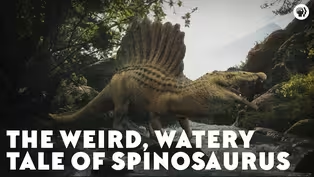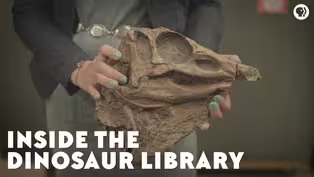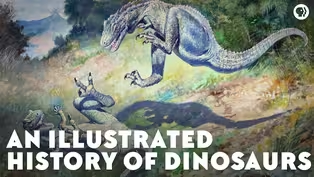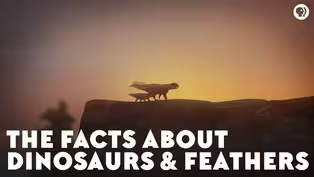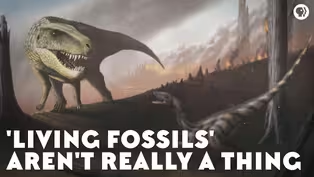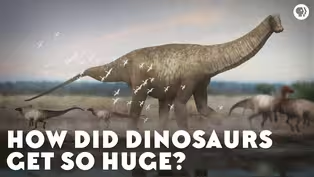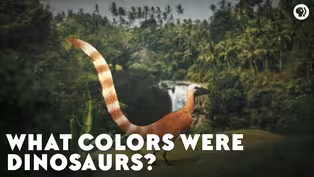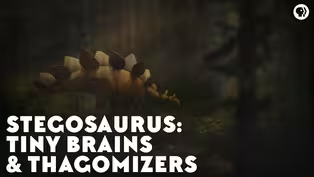
How the T-Rex Lost Its Arms
Season 1 Episode 47 | 6m 54sVideo has Closed Captions
Tyrannosaurus rex had tiny arms. How did this happen, and why did it keep them?
Tyrannosaurus rex was big, Tyrannosaurus rex was vicious, and Tyrannosaurus rex had tiny arms. The story of how T-Rex lost its arms is, itself, pretty simple. But the story of why it kept those little limbs, and how it used them? Well, that’s a little more complicated.
Problems playing video? | Closed Captioning Feedback
Problems playing video? | Closed Captioning Feedback

How the T-Rex Lost Its Arms
Season 1 Episode 47 | 6m 54sVideo has Closed Captions
Tyrannosaurus rex was big, Tyrannosaurus rex was vicious, and Tyrannosaurus rex had tiny arms. The story of how T-Rex lost its arms is, itself, pretty simple. But the story of why it kept those little limbs, and how it used them? Well, that’s a little more complicated.
Problems playing video? | Closed Captioning Feedback
How to Watch Eons
Eons is available to stream on pbs.org and the free PBS App, available on iPhone, Apple TV, Android TV, Android smartphones, Amazon Fire TV, Amazon Fire Tablet, Roku, Samsung Smart TV, and Vizio.
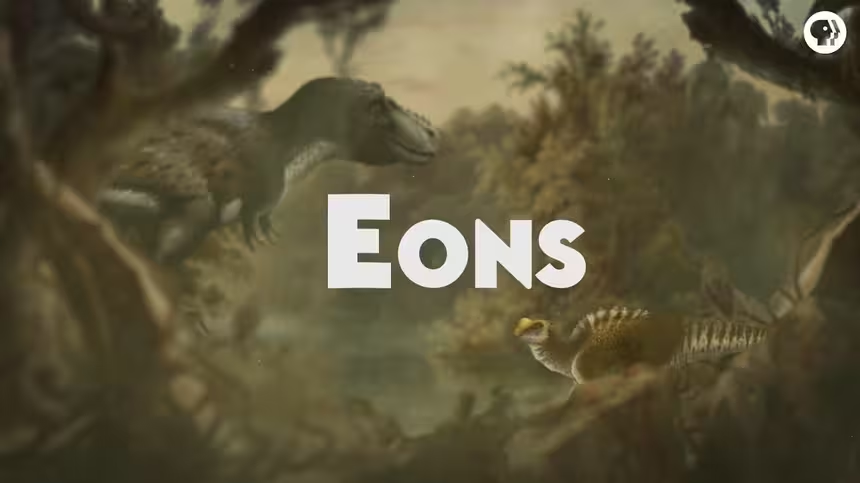
Welcome to Eons!
Join hosts Michelle Barboza-Ramirez, Kallie Moore, and Blake de Pastino as they take you on a journey through the history of life on Earth. From the dawn of life in the Archaean Eon through the Mesozoic Era — the so-called “Age of Dinosaurs” -- right up to the end of the most recent Ice Age.Providing Support for PBS.org
Learn Moreabout PBS online sponsorshipMore from This Collection
Eons videos all about Dinosaurs
The Weird, Watery Tale of Spinosaurus
Video has Closed Captions
In 1912, a fossil collector discovered the world’s only known semi-aquatic dinosaur. (7m 28s)
Video has Closed Captions
We talk to Amy Atwater, Collections Manager at the Museum of the Rockies. (7m 19s)
An Illustrated History of Dinosaurs
Video has Closed Captions
Our image of dinosaurs has been constantly changing since naturalists started studying the (12m 20s)
The Facts About Dinosaurs & Feathers
Video has Closed Captions
Dinosaurs have been found with some sort of fluff or even full-on plumage. (10m 1s)
Living Fossils' Aren't Really a Thing
Video has Closed Captions
Even the most ancient-looking organisms show us that evolution is always at work. (5m 5s)
How Did Dinosaurs Get So Huge?
Video has Closed Captions
Creatures as tall as a five-story buildings shook the Earth. (5m 42s)
Video has Closed Captions
We know a lot about dinosaurs but there’s one question that has plagued paleontologists.. (5m 2s)
Stegosaurs: Tiny Brains & Thagomizers
Video has Closed Captions
If you take it as a given that extinct dinosaurs were all weird and wonderful, then you go (4m 49s)
Providing Support for PBS.org
Learn Moreabout PBS online sponsorshipIf there are three things any 6-year-old knows about dinosaurs, it's that: Tyrannosaurus rex was big, Tyrannosaurus rex was vicious, and Tyrannosaurus rex had tiny arms.
T. rex dominated the Western United States during the Cretaceous Period, from 68 million to 66 million years ago.
And in its day, was the largest carnivore on land.
But for such a fearsome predator, it certainly had its quirks - like those teeny tiny arms, the source of so many jokes about how a tyrannosaurus couldn't do push ups, or give a decent high five.
Even from a biological perspective, they look pretty small.
The average T rex weighed about 10,000 kilograms, and stood between four and a half to 6 meters tall.
But its two-fingered forelimbs were less than one eighth as long as its hindlimbs - probably only a little bigger than your own arms.
And the story of how T-Rex lost its arms is, itself, pretty simple.
But the story of why it kept those little limbs, and how it used them?
that's a little more complicated.
The short answer as to why T. rex had tiny arms was, well, they ran in the family.
Early ancestors of the genus Tyrannosaurus included the prosauropods, which first appeared way back in the Triassic, and had forelimbs just as long as their hindlimbs.
But as time went on, more and more of these early dinosaurs became bipedal.
And once they were standing on their hind legs, their front limbs were suddenly freed up to be used in different ways.
And many of the early carnivorous bipedal dinosaurs had sharp claws on their forelimbs, which made them more useful for hunting with than for standing on.
But the group that wound up producing Tyrannosaurus rex took an evolutionary right turn somewhere in the Jurassic, 150 million years ago.
Instead of relying on their forelimbs to help them hunt, members of the superfamily known as Tyrannosauroidea - which includes Tyrannosaurus and its relatives - started to use their jaws One of the earliest Tyrannosaurs is Guanlong, a small, 150-million-year-old dinosaur from China.
Guanlong had a tiny head, and long forelimbs - well, long for a Tyrannosaur anyway, about half the length of its legs.
But fast forward about 25 million years in China and you find Raptorex , which had the same basic body plan, but with different proportions.
Raptorex was still only about 1 meter tall, but its head was about one-third larger than Guanlong's, and its forelimbs were about half as long.
So, Raptorex looked a lot like a tiny, pocket-sized version of Tyrannosaurus rex - but it shows up in the fossil record about 70 million years before T. rex did.
That means that the characteristics we think of as defining T-rex -- namely a huge head and tiny forelimbs - were actually part of a 90-million-year trend in that direction.
And that big head wasn't just for looks.
Its enormous jaws gave T. rex a bite force up to 57,000 Newtons, which is enough power to pulverize bone.
With a bite that nasty, having long forelimbs really wasn't necessary.
But beyond that, long arms weren't just "not needed" - for some dinosaurs, they were kind of in the way.
That's because of how bipedal dinosaurs walked.
We swing our arms when we walk and run, to help us maintain balance to keep our upper body stable.
But dinosaurs like tyrannosaurs had long, rigid tails, which acted as stabilizers.
So they didn't need to swing their arms.
If anything, having big forelimbs would have just slowed them down.
From what we know about the mechanics of their bones and musculature, we know that the natural body posture for many tyrannosaurs was with their forelimbs tucked close to their body.
Some specimens have even been found in this position as fossils!
This type of research, by the way, is also how we know that Tyrannosaurus and other carnivorous dinosaurs held their forearms with their palms facing each other, and that they didn't have the wrist mobility to hold them facing down.
So, when you're doing your T. rex impression, make sure you're like ahhhh Never like this.
That's inaccurate!
And if you want to be totally accurate about it -- and of course you would, because why wouldn't you?
- - then you should only use your thumb and your forefinger, because those two digits are the ones that T. rex retained.
So like ahhhhhhh So that's how Tyrannosaurus rex, or Tyrannosauroidea in general, lost their big arms: Over 90 million years, their heads got bigger, as their jaws became their primary weapons.
And their forelimbs got smaller, because that probably made it easier for them to move around.
But, T-rex still had arms!
If they were such a liability, why didn't it just lose them entirely?
Well, that's a little more complicated.
Initially, paleontologists thought that T. rex forelimbs were vestigial, just leftover relics of true arms that were so small as to be useless.
But after lots of study of some well-preserved fossil finds, we've learned that their forelimbs were covered in muscle attachments.
So, while they weren't very strong, their arms could move.
So what could they have been used for?
One of the most common theories is that T. rex used its forelimbs during mating.
Studies on the biomechanics of its arms have shown that they were pretty powerful at adduction, which is the technical term for the movement you make when you hug something.
So, adduction could've been used either as part of courtship - cuz who doesn't like a good cuddle?!
-- or to help hold male Tyrannosaurus in place during mating.
However, other scientists think T. rex could have used its limbs not for loving but for fighting.
Its fingers, after all, were tipped with claws that were about a quarter the length of the whole forelimb.
Still, that's less than half as large as one of their teeth.
And although the arms were muscular, they didn't measure up to force of its bone-crunching bite.
So if these arms were used to slash at prey, it was only as a supplement for the killing power of its jaws.
Others have suggested that T. rex used its hugging skills to kill, planting its forelimbs into its prey while biting down, dealing a death blow and a death hug at the same time.
And of course, it's always possible that there wasn't actually any use for these tiny forelimbs.
Maybe T. rex arms were what we call a spandrel - a byproduct of other evolutionary changes that doesn't necessarily have a purpose or advantage of its own.
Over millions of years, Tyrannosauroidea followed an evolutionary course toward having smaller forelimbs and bigger heads.
So maybe, if they hadn't gone extinct, the descendants of T rex would have had gone one step further and lost their forelimbs entirely.
Truth be told, if we're ever going to really know how Tyrannosaurus rex used its arms - if it did at all - we're going to need to find more fossils.
For example, to figure out if T. rex used its forelimbs for slashing, paleontologists would need to find a fossil that had slash marks that clearly came from T. rex claws.
And we haven't found that yet.
And, even more challenging, to know whether Tyrannosaurus rex used its forelimbs during mating, we'd have to find two T. rexes preserved "in the act", so to say.
And that would be a remarkable find But that's part of what makes paleontology so interesting - there are always more questions to be answered.
To figure them out, we just have to dig up the right fossils.


- Science and Nature

A documentary series capturing the resilient work of female land stewards across the United States.












Support for PBS provided by:

